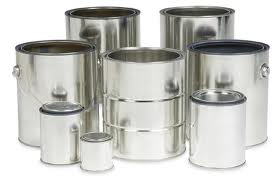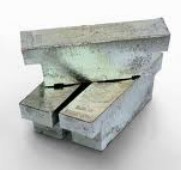Tin - (Sn)
Melting
Point: 450
Fahrenheit
\ 232
Celsius
Boiling Point: 4716 Fahrenheit \ 2602 Celsius

Tin is a silvery-white metal in appearance commonly seen as the shinny silver coating on many other metals like cans.
Malleable Metal
Tin is malleable at ordinary temperatures but is brittle when cooled. It’s easy to cast and form this soft, malleable material. Because of its hardening effect on copper, tin was used in bronze implements.
Tin is normally considered nontoxic and readily alloyed with lead, antimony, silver, copper, and other metals to form solder and Babbitt materony and lead. The first alloy, used in large scale since 3000 BC, was bronze, an alloy of tin and copper. Whereas Pewter is an alloy of 85–90% tin with the remainder commonly consisting of copper, antimony and lead. Tin is used in many alloys, most notably tin / lead soft solders, typically containing 60% or more of tin. Another large application for tin is corrosion-resistant tin plating of steel as it is not easily oxidized in air and is used to coat other metals to prevent corrosion.
Because of its low toxicity, tin-plated metal is also used for food packaging, giving the name to tin cans, which are made mostly of steel. Tin resists corrosion from water but can be attacked by acids and alkalis. "Tinning" is the process of thinly coating sheets of wrought iron or steel with tin, and the resulting product is known as tinplate. It is most often used to prevent rust. Tin can also be highly polished.
Tin which in itself is a precious and expensive metal and does not occur as the native element but must be extracted from various ores. Although Tin is the 49th most abundant element, it is a relatively scarce element with an abundance in the earth's crust of about 2 parts per million (ppm), compared with 94 ppm for zinc, 63 ppm for copper, and 12 ppm for lead. it is estimated that, at current consumption rates and technologies, the Earth will run out of tin that can be mined in 40 years. However it has been suggested tin could run out within 20 years based on an extremely conservative extrapolation of 2% growth per year.
Secondary, or scrap, tin is also an important source of the metal. The recovery of tin through secondary production, or recycling of scrap tin, is increasing rapidly. Whereas the United States has neither mined since 1993 nor smelted tin since 1989, it was the largest secondary producer, recycling nearly 14,000 tons in 2006

About Metal Spot Prices: The spot price of metals is based on paper contracts for delivery of tons of pure metal ingots. When you're not prepared to pay for and take delivery of tons of metal ingots, that spot price will quickly become a huge understatement of the real price of that metal. When you want to buy just a few pounds of Tin for example, you're looking at substantially higher prices. Moreover, once you own physical Tin ingots, make absolutely sure you never sell for the spot price of Tin. Because it's hard to get ingot grade Tin in physical form, you've got something special on your hands and make sure to extract the full value when you're selling and understand the reverse when buying.
Tin ingots are currently selling in the Twenty dollar range per pound and rising.
Boiling Point: 4716 Fahrenheit \ 2602 Celsius

Tin is a silvery-white metal in appearance commonly seen as the shinny silver coating on many other metals like cans.
Malleable Metal
Tin is malleable at ordinary temperatures but is brittle when cooled. It’s easy to cast and form this soft, malleable material. Because of its hardening effect on copper, tin was used in bronze implements.
Tin is normally considered nontoxic and readily alloyed with lead, antimony, silver, copper, and other metals to form solder and Babbitt materony and lead. The first alloy, used in large scale since 3000 BC, was bronze, an alloy of tin and copper. Whereas Pewter is an alloy of 85–90% tin with the remainder commonly consisting of copper, antimony and lead. Tin is used in many alloys, most notably tin / lead soft solders, typically containing 60% or more of tin. Another large application for tin is corrosion-resistant tin plating of steel as it is not easily oxidized in air and is used to coat other metals to prevent corrosion.
Because of its low toxicity, tin-plated metal is also used for food packaging, giving the name to tin cans, which are made mostly of steel. Tin resists corrosion from water but can be attacked by acids and alkalis. "Tinning" is the process of thinly coating sheets of wrought iron or steel with tin, and the resulting product is known as tinplate. It is most often used to prevent rust. Tin can also be highly polished.
Tin which in itself is a precious and expensive metal and does not occur as the native element but must be extracted from various ores. Although Tin is the 49th most abundant element, it is a relatively scarce element with an abundance in the earth's crust of about 2 parts per million (ppm), compared with 94 ppm for zinc, 63 ppm for copper, and 12 ppm for lead. it is estimated that, at current consumption rates and technologies, the Earth will run out of tin that can be mined in 40 years. However it has been suggested tin could run out within 20 years based on an extremely conservative extrapolation of 2% growth per year.
Secondary, or scrap, tin is also an important source of the metal. The recovery of tin through secondary production, or recycling of scrap tin, is increasing rapidly. Whereas the United States has neither mined since 1993 nor smelted tin since 1989, it was the largest secondary producer, recycling nearly 14,000 tons in 2006

About Metal Spot Prices: The spot price of metals is based on paper contracts for delivery of tons of pure metal ingots. When you're not prepared to pay for and take delivery of tons of metal ingots, that spot price will quickly become a huge understatement of the real price of that metal. When you want to buy just a few pounds of Tin for example, you're looking at substantially higher prices. Moreover, once you own physical Tin ingots, make absolutely sure you never sell for the spot price of Tin. Because it's hard to get ingot grade Tin in physical form, you've got something special on your hands and make sure to extract the full value when you're selling and understand the reverse when buying.
Tin ingots are currently selling in the Twenty dollar range per pound and rising.